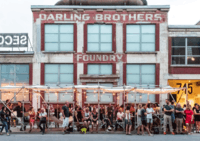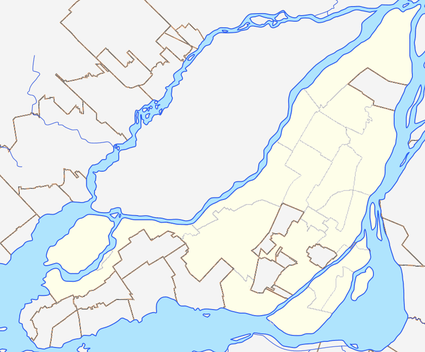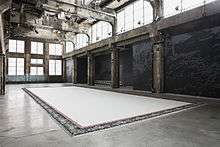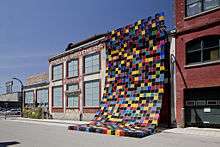Darling Foundry
The Darling Foundry (French: Fonderie Darling) is a contemporary art complex located in the Cité du Multimédia district of Montreal, Quebec, Canada. Located in a former foundry, the complex consists of an art gallery and artists studios.
Fonderie Darling | |
 | |
 Location of the Fonderie Darling in Montreal | |
| Established | 2002 |
|---|---|
| Location | 745, rue Ottawa Montreal, Quebec, Canada |
| Coordinates | 45°29′51.78″N 73°33′24.29″W |
| Type | Visual Art Center |
| Website | www |


Its mission is to support the creation, production, and dissemination of visual art; it seeks at once to question the role of art and artists in the heart of the city, and to promote that role.
Description
The Darling Foundry is located in an industrial building that was used by the Darling company between 1889 and 1971 to produce metal castings for industrial equipment.[1][2] The building ceased to be used for commercial purposes in 1991.[3]
In 1993, Montreal cultural organization Quartier Éphémère began to invest in 'in situ' projects within vacant or abandoned Montreal industrial buildings and to reach a diverse public, off of the beaten track of contemporary art. The Darling Foundry is one of QE’s projects.[4] By turning buildings which were about to be demolished into artistic place, the association saved a total of 3500 square meters in the Faubourg des Recollets’s area.
The Darling Foundry visual arts centre started its activity by opening its exhibition area in 2002. In 2006, the association inaugurated 12 artists studios in the second part of the building. The building is classified as an "exceptional heritage value building" in the Montreal Built Heritage great repertoire. Its transformation from a foundry into an art center was one of the first industrial heritage recycling success.
Darling Foundry supports different kinds of projects, sometimes highly technological, or risky, but always experimental, and open to the world of possibilities.
History
The foundry was constructed in 1880 by the Darling brothers due to the high demand for metal in the construction of machinery, ships and the railway. It was later expanded several times between 1888 and 1918.[5] Once complete, the complex consisted of four buildings, each with a specific role in the process of the foundry.[5] The foundry became the second largest in Montreal, was at full capacity until the 1970s and employed 800 people.[5]
The foundry was purchased by the Pumps & Softener Company in 1971, amid a downturn in the industry. The foundry eventually shut down completely in 1991.[5]
Arts organization Quartier Éphémère moved into the complex in the 1990s. The city of Montreal owned the building and let the organisation move in at no charge in exchange for maintaining the building and turning it into an events venue.[5][6] The building was in disrepair when Quartier Éphémère moved in, however, by the early 2000s, financing was obtained and the building was renovated.[5][6]
Today, the building contains 3,500 square metres (38,000 sq ft) of space dedicated to the visual arts.[6]
References
- Nancy H. Dunton; Helen Malkin (2008). A Guidebook to Contemporary Architecture in Montreal. Douglas & McIntyre. pp. 68–. ISBN 978-1-55365-346-2.
- International Molders' and Foundry Workers' Journal. International Molders' and Foundry Workers' Union of North America. January 1961.
- Rhona Richman Kenneally; Johanne Sloan (2010). Expo Sixty Seven. University of Toronto Press. pp. 213–. ISBN 978-0-8020-9708-8.
- Conseil jeunesse de Montréal (20 June 2017). Opinion Paper on the use of vacant space in Montréal: a youth perspective. Conseil jeunesse de Montréal. pp. 82–. ISBN 978-2-7647-1562-8.
- McMullan, Thomas J. "The Darling Foundry: Once Heart of Industry Now Home to Artists". The Main Media. Retrieved 22 February 2016.
- "Quartier Éphémère and the Darling Foundry". Heritage Montreal. Retrieved 22 February 2016.